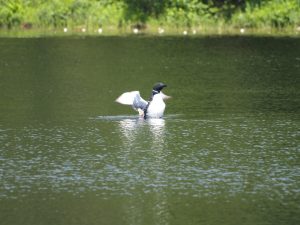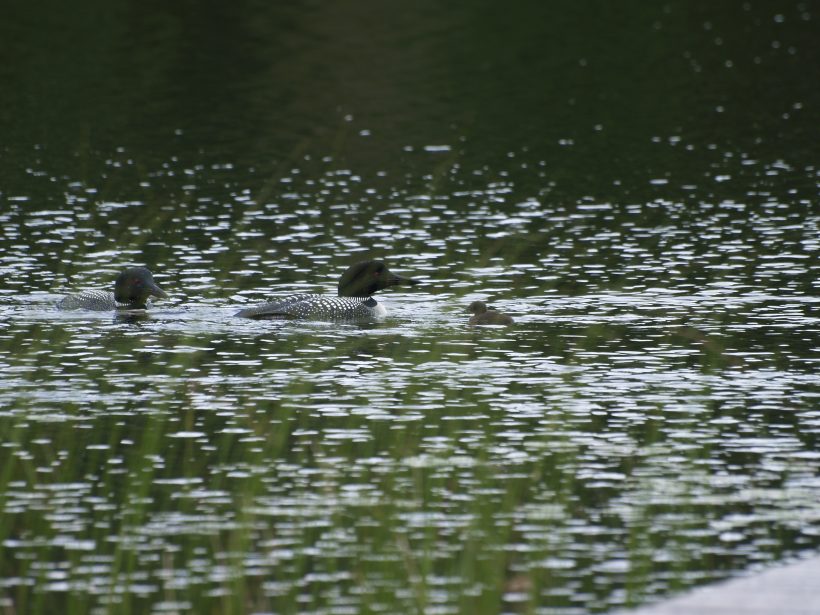ABOUT LOONS
Much of this information is provided by Kathy Jones (Volunteer Manager, Ontario Programs and the Canadian Lakes Loon Survey) and Dr. Doug Tozer (Director, Waterbirds and Wetlands), Birds Canada. Should your memory be flickering, Tozer’s father Ron was an Algonquin Park Naturalist and his mother Pat a founding General Manager of The Friends of Algonquin Park which operate the bookstores in the Visitor Centre and Logging Museum; the proceeds of which go to further education and research in Algonquin Park. I first met them when researching my book The Algonquin Centennial Series, which is still available in local bookstores.
As readers know the Common Loon often returns to the same lake annually. The male chooses a nesting site along the shoreline. The females incubate the eggs more than the male and both actively raise the young and protect them against other loons, waterfowl, and wildlife that compete for fish, their main prey.
Loons use short, soft calls during courtship and nest building; ‘hoots’ for close conversation. Chicks ‘peep’ and use descending ‘yelps’ while begging for food. The ‘wail’ call is haunting, like a wolf howl and helps keep in touch. The number of notes in a ‘wail’ are thought to be related to anxiety: the more notes the greater the anxiety. That laughing sound is called a ‘tremolo’ yet it is a stress call and is the only call used during flight. In the spring time male loons use a ‘yodel’ call to establish territory and to tell unwanted guests to stay away. The ‘yodel’ consists of three introductory notes followed by repeated phrases of variable length. In subtle ways, each male’s ‘yodel’ is unique and they seem to recognize neighbouring males from year to year.
During the breeding season loon pairs do “circle dances” when meeting other loons. During the dance, three or more loons swim in a circle, dipping their heads under water while quickly looking at each other. These dances are often associated with a territorial invasion by a non-breeder. The invader uses the ‘tremolo’; the territorial male responds with a ‘yodel’ and the dance suddenly changes with a quick circle. The invader either leaves or turns “spectacularly violent” with the male fighting a male invader or female fighting female. If the invader is chased off life continues as before but if the invader wins the other territory member accepts the new loon as partner and if there are chicks they are often killed. Male-to-male fights often result in the death of the territorial male.

As the chicks mature and the risk of them being eaten by a predator diminishes, loons start participating in “social gatherings” that consist of 3 to 15 individuals during which they just appear to be looking at each other. This is more common in territories where there has been a recent “divorce” and the birds are looking for a new mate.
After breeding, loons stop distancing and may join a fishing party. During migration in late summer and on the wintering grounds loons often gather in groups of as many as 250. This allows them to better pursue schools of fish, particularly those found in the near-shore waters of the Pacific and Atlantic oceans and the Gulf of Mexico where most loons overwinter. During this time social distancing isn’t as much an issue as during the breeding season and the most common call is the ‘hoot’.
In the spring the loons return to their nesting lakes and the cycle continues.
According to another source, a pair of loons require a lake at least 10 acres in size, although they prefer 50 acres or more. The density of cottages, disruption of natural shoreline habitat and the constant disturbance by watercraft negatively impact their presence. Apparently data from the Breeding Birds of Ontario informs us that you have a 36% chance of seeing a loon if you are in loon habitat, common to the black fly and mosquito.
